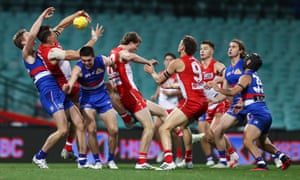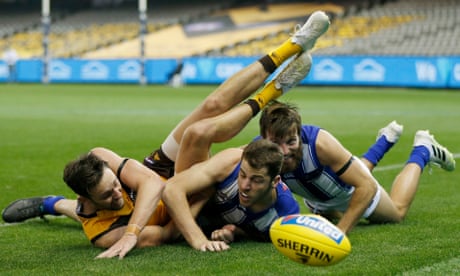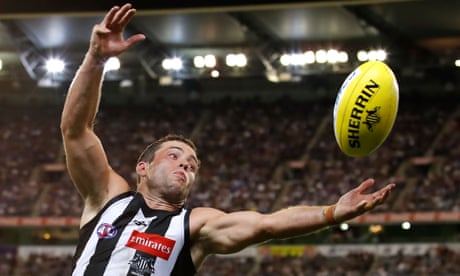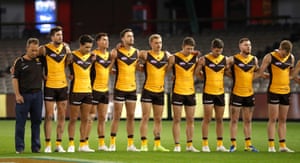Finally a journalist telling it like it is...
An increasingly hard sell: just what has happened to AFL football?
How did we arrive here? Who, or what, is to blame? And is there a solution? Jonathan Horn breaks down the game’s current malaise
 ‘The footy field has never been more crowded and at its worst, it resembles a mosh pit.’ Photograph: Brendon Thorne/AAP
‘The footy field has never been more crowded and at its worst, it resembles a mosh pit.’ Photograph: Brendon Thorne/AAP
In April and May, there was a yawning ache for football. But we didn’t ache for this. We should not be surprised, of course. The game has been tracking this way for some time. It is also being played in the midst of a global pandemic, with cardboard cutouts flapping in the breeze and with most of the players having done bugger all training for two months.
But many of the games have been ghastly. Scores are low. Viewers are tuning out. For generations weaned on high scores and exquisite skills, footy in 2020 is an increasingly hard sell. “Our game’s in a dreadful space at the moment,” Alastair Clarkson said on Sunday. Even Shane Warne has weighed in with his five-point plan to fix football. But how did we get here? Who, or what, is to blame? And is there a solution?

The AFL is in a 'dreadful space' but concern over lost aesthetic is not new
It’s a coach’s game
In poker, the most despised players are known as nits. They only bet big when they have a crack hand. They choke the game. They bore everyone else into submission. To many, modern football is controlled, has been mastered and is slowly being sent up the spout by very smart, very defensively minded men who in many ways have clocked this sport. As footballers, nearly all of them were defenders and scrappers. They made up for their lack of natural talent and flair by working the locks, by playing on the edge, and by wringing every drop of ability out of themselves. As coaches, they are derided as being risk averse and prescriptive.
Gillon McLachlan – who has more than enough on his plate right now – recently begged the coaches to be more attacking, to try something different, and to be more ballsy. Some, including Ken Hinkley and Stuart Dew, have answered the call. But the modern day master coaches lie in wait. They will study them and stifle them. They will suffocate and surge. They will pick holes, get the game on their terms and win by any means necessary, as per their job description. As Ross Lyon said several years ago, “it’s easier to destruct than to create”.
The game has been suffocated
For decades, Australian rules football was a pretty unsophisticated caper. “Long bombs to Snake”, “you kick 23…we’ll kick 25” and “we have the ball, they have the ball, the ball is in dispute”, were some of the various approaches. But when you make a sport fully professional, drown it in money, radically change the way players are conditioned and recruited, and cram as many assistant coaches into a box as health and safety regulations permit, you are going to be left with a very different product.
As James Coventry’s excellent book Time and Space highlighted, many of football’s innovations have came from outsiders. The press was the brainchild of a West Australian who dabbled in water polo. The huddle came from an American who had never seen a game of Australian football. In the case of interchange rotations, the trailblazers were an unheralded coach and his 29-year-old fitness advisor. Footy, Coventry stresses, is constantly evolving. It always solves its own problems. And it always endures.

But whoever can help de-clutter the modern game – even if it is a pen pusher or a number cruncher at league headquarters – deserves their own statue at the MCG. Football is now almost exclusively played and defended in zones. Matthew Scarlett says his players are coached to defend, even when they have the ball and are streaming into attack. The footy field has never been more crowded. At its worst, it resembles a mosh pit. Only in the final few minutes do coaches release the shackles. Dermott Brereton likens it to a bicycle pursuit race, where everyone rides cautiously, sizing one another up and cooling their jets until the final lap, at which point they all go like the clappers.
Many want to drastically reduce the number of rotations. Others, including Leigh Matthews, Chris Scott, Clarkson and Lyon, have said we need to trial 16-a-side football. The concern is whether they are the right men to be setting the agenda. Besides, AFLX was open, attacking and ballistic, and it was one of the most prosaic sporting experiences ever dished up.
Alastair Clarkson with his Hawthorn players. Photograph: Michael Willson/AFL Photos/Getty Images
The talent pool has thinned
A decade ago, the AFL added two clubs that barely anyone wanted. Suddenly, there were 44 footballers running around every weekend who otherwise would have been playing at the lower levels. Even before Covid-19 struck, those competitions and traditional pathways had stalled. Tasmanian football had been left to rot. Country football was struggling. A remarkable number of teenagers were now being drafted via the Victorian private school system. Kids from disadvantaged backgrounds and remote communities were increasingly being lost to the game.
There are harder questions to answer. Are young men in Australia simply not as proficient at football as they were several decades ago? Do they now have so many distractions, and are they so cossetted, that they are not as well equipped to play what is a brutal and technically demanding sport? “The generations of today have more options,” Port Adelaide list manager Jason Cripps told the Herald Sun in 2017. “They’re not kicking the footy in the backyard, they’re not kicking it at school [and] a lot of them are sitting on devices. I’m talking the age of five to 15, so by the time they get in the talent pathway program it’s too late.” It is a view echoed by Western Bulldogs coach Luke Beveridge. “We get to a point where they’re 18 and mid-20s players and they still have a long way to go with their skills,” he said. “The skill level has dropped off over time and that’s partly because of what’s happened through the pathways.”
Footy has a Channel Seven problem
Like never before, football is in the hands of the host broadcasters. Over at Fox Footy, they at least put the effort in. They have callers who are skilled in their craft. They have expert commentators who seem to take their job seriously. Crucially, they endeavour to explain the mysteries of the modern game.
On Channel Seven however, they cannot decide whether each football game is the biggest sporting event since the Thriller in Manila, or a bit of a lark, a bit of a piss-take. They often go from hyperbolic to bored senseless in the space of a quarter, sometimes in the space of one sentence. Every game is boiled down to talking points. The banter, the banality and the blokiness is a major turn off.
So too, incidentally, is the footy industry’s preoccupation with utter trifles. It may be the optics of Max Gawn’s new haircut or the science of Conor McKenna’s nostril clearing. The usual suspects chime in, crap on, stroke their chins, puff their chests and bore us to sleep. We are left with a noisy, bloated, reactive and increasingly censorious “industry” that could not be further up its own fundament.
No-one knows what the rules are
Umpiring is one of the toughest jobs in football. But it is a mess. I have been playing and watching football since I was five. I have no idea what the rules are anymore. They are impossible to explain to someone new to the game. They’re in a constant state of flux. Everyone is flummoxed – fans, coaches, players, even the umpires themselves.
The holding the ball rule, in particular, is incomprehensible. The way the deliberate out of bounds rule is interpreted reflects an umpiring fraternity with no innate feel for the game. The ruck nomination rule has run its race and simply gives defenders more time to re-set. And the decision making around rucking, ducking, blocking, chopping, tunnelling and diving seems to change from contest to contest, and from umpire to umpire.
Footy has been in the doldrums before. The 1980s saw a significant drop off in crowds and interest. Many of the clubs were broke. The same clubs dominated most years. Many were run by men who were completely taking the piss. Some were corporate criminals. Some were complete crackpots. It seems comical now but journalists regularly lamented the drop off in standard. There were articles about the existential threat of basketball. In 1987 - a year where the average weekly score per team was 107 – seven former legends were empanelled to figure out how to fix footy and ease congestion.
But the current malaise is something else altogether. AFL football is at a crossroad. The governing body’s leadership during the pandemic has been outstanding. But when the restrictions ease and the crowds return, they will have some big decisions to make. Footy cannot go on like this. “Australia’s great athletic invention” as Martin Flanagan once called it, is increasingly unrecognisable and needs a serious intervention.



